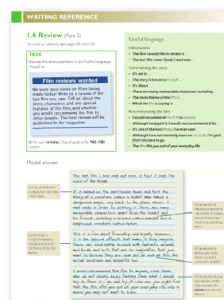Preparing our students for high stakes exams can be a daunting task. We want them to know the exam inside out, we’ll need to give them plenty of practice and we still aim to keep our lessons engaging and fun! This post is concerned with Part 2 of the First writing exam: what should we teachers bear in mind?
What types of questions are there?
We might establish five different types of questions that appear in this section, namely:
- Article
- (semi) formal letter or email
- Informal letter or email
- Review
- Report
Each of these task types have their own conventions. Can you match up the Dos and Don’ts below to the task types above (answers at the end of the post!)?
A) Divide it into sections. You may include bullet points and headings.
B) Include specific details and give your opinion . Use vivid language to add interest.
C) Avoid contractions, colloquial language, direct questions and informal punctuation such as exclamation marks.
D) Open with an informal greeting. Use contractions. Short sentences are acceptable.
E) Use direct or indirect questions to add colour and involve the reader. Give it a catchy title to grab the reader’s attention.
Are we clear on the assessment criteria? Are our students?
This is a simplified version of the marking criteria:
| CONTENT | COMMUNICATIVE ACHIEVEMENT | ORGANISATION | LANGUAGE |
| Have you done what the task asked?Have you covered all the points? | Is your answer appropriate and have you used the right register? | Is your answer logical and ordered? | Have you used a wide range of vocabulary and grammar?Is your writing accurate? |
How can we get our students familiar with what’s required? Well, we can give them a score out of 5 for each area, rather than an overall score: this way they have more information on where they need to improve. We can also share writing samples among the class and get them to compare, discussing how the pieces would score in different areas, so they start to get a ‘feel’ for what is required. Finally, benchmarking among teachers of different classes (different teachers grading the same pieces of writing) can ensure consistency at a centre level.
A good coursebook (such as Gold or Expert), in addition to providing process writing questions in every unit will have a writing reference section at the back: these typically include model answers with good practice highlighted and key language structures. Always encourage students to do writing homework and practice with their trusty writing reference by their side.
To go a step further, what about collaborative class writing reference posters? The models can be student work and students can also include common errors to be aware of as well as key vocabulary around certain recurrent themes (think a film / restaurant / concert) review. Of a digital inclination? What about getting your class to collaborate on a padlet?
In the exam…
Get that highlighter out!
Students will need to carefully analyse the demands of the questions before steaming in – this way they’re more likely to write an appropriate answer, both in terms of content and register. Let’s get our students in the habit of looking for this information in the questions, and highlighting it:
Who am I writing to / for?
What style to I need?
What information do I need to include?
How many points do I need to make?
Have a plan!
As well as making a plan for both pieces of writing they need to do, having an overall plan for time-management makes sense (and doing practice timed pieces of writing can help students develop their personal ‘plan of attack’). We have 80 minutes and, if we spread this time evenly between two questions, a possible plan (one that I used to use) is 10 minutes for planning, 25 for writing and 5 for checking each piece. Regardless of how we split the time, planning and checking are key and are processes we’ll need to work on with our students.
On the subject of checking…
When marking student writing, it makes sense to compile the most common errors and give them to the class to correct, rather than students just correcting their own mistakes. This can preempt mistakes and will gives students things to look out for when checking their work. It can also inform our poster (think mistakes typical of certain task types. Eg ‘I recommend you to introduce’ in a report).
Celebrate good practice!
Finally, as well as compiling errors, in my classes I’ve always found it useful to compile sentences with examples of good practice from students (impressive vocabulary, complex grammar structures, etc) and get the class to work out what I was impressed with. As well as learning from each other, it was also very motivational and a source of great pride for students to have their work highlighted.
What strategies do you use to prepare students for writing exams?
Answers
A) Report
B) Review
C) (semi) formal letter or email
D) Informal letter or email
E) Article
You might also be interested in…
– Top tips for passing the FCE (First Certificate in English)
– Top tips for passing the CAE (Cambridge Advanced English)
– 7 tips for English exams to help you prepare
– 10 best practices for tackling English language exams
– PTE, TOEFL, IELTS, TOEIC, Cambridge exams… Which English exams should I choose?




